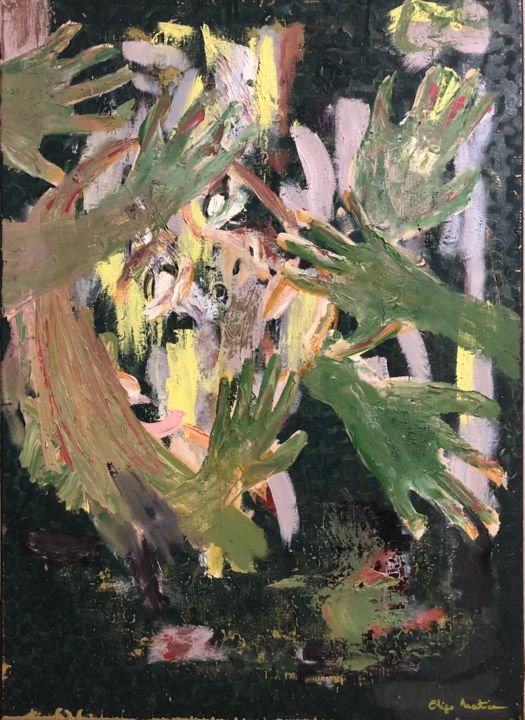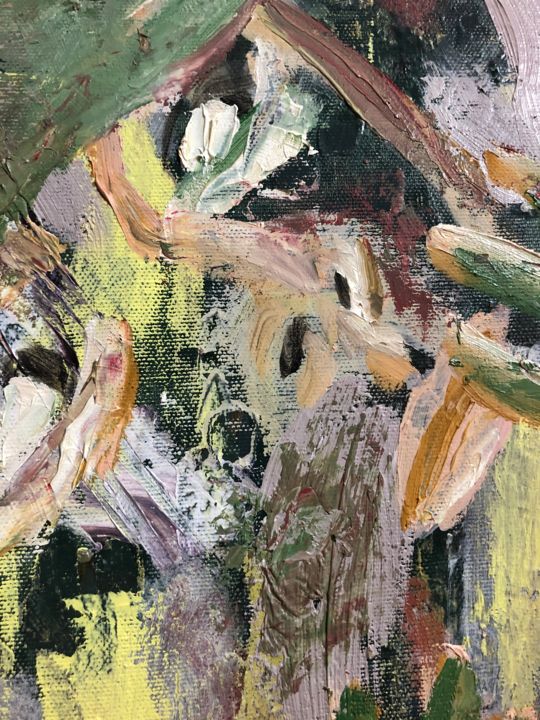





Social anxiety (2019) Painting by Eliza Matica
Not For Sale
Seller Eliza Matica
"Fine-Arts" prints on paper
It is a process of printing on art paper using very high-quality pigment inks and printed in very high definition. Its level of conservation is exceptional (more than 100 years), its quality, depth, and richness of nuances exceeds the classic photo print on Argentic paper.

Glossy finish
Apart from its exceptional thickness, the fiber paper is composed of an alpha-cellulose base without acid and it is covered with barium sulphate, and a microporous layer absorption enhancing pigments during printing. A pure white color, non-yellowing to light, this paper is especially designed for resistance and aging. It is used by major museums worldwide as it offers excellent resolution, rendering deep and dense colors.
Art Print "Fine Art" - Glossy finish on a fiber base paper 325 g.

Our high end prints and reproductions
ArtMajeur only uses natural papers with neutral pH, resistant, and of high quality, selected from renowned papermakers!
Constant attention is paid by our master printer, whether in terms of color control or respect for the graphic chain. Our high level of quality requirement is a major asset of ArtMajeur framed art prints.
For Artists! You help artists to live from their work. They receive royalties everytime you buy their prints.
About our fine printsPurchase a license to use this image for your website, communications or to sell merchandise.
Usage: Web Licence
| 1093 px | ||

|
1500 px |
| Dimensions of the file (px) | 1093x1500 |
| Use worldwide | Yes |
| Use on multi-support | Yes |
| Use on any type of media | Yes |
| Right of reselling | No |
| Max number of prints | 0 (Zero) |
| Products intended for sale | No |
Download immediately upon purchase
This image is available for download with a licence: you can download them at anytime.
Restrictions
All images on ArtMajeur are original works of art created by artists, all rights are strictly reserved. The acquisition of a license gives the right to use or exploit the image under the terms of the license. It is possible to make minor modifications such as reframing, or refocusing the image so that it fits perfectly to a project, however, it is forbidden to make any modification that would be likely to harm the original work In its integrity (modification of shapes, distortions, cutting, change of colors, addition of elements etc ...), unless a written authorization is obtained beforehand from the artist.
Custom licences
If your usage is not covered by our standard licences, please contact us for a custom licence.
Art image bank-
Original Artwork (One Of A Kind)
Painting,
Oil
on Canvas
- Dimensions Height 27.6in, Width 19.7in
- Framing This artwork is not framed
- Categories Paintings under $5,000 Figurative
Social anxiety disorder is a persistent fear of one or more situations in which the person is exposed to possible scrutiny by others and fears that he or she may do something or act in a way that will be humiliating or embarrassing. It exceeds normal "shyness" as it leads to excessive social avoidance and substantial social or occupational impairment. Feared activities may include almost any type of social interaction, especially small groups, dating, parties, talking to strangers, restaurants, interviews, etc.
Those who suffer from social anxiety disorder fear being judged by others in society. In particular, individuals with social anxiety are nervous in the presence of people with authority and feel uncomfortable during physical examinations.
People who suffer from this disorder may behave a certain way or say something and then feel embarrassed or humiliated after. As a result, they often choose to isolate themselves from society to avoid such situations. They may also feel uncomfortable meeting people they do not know, and act distant when they are with large groups of people. In some cases, they may show evidence of this disorder by avoiding eye contact, or blushing when someone is talking to them.
A previous negative social experience can be a trigger to social phobia,perhaps particularly for individuals high in "interpersonal sensitivity". For around half of those diagnosed with social anxiety disorder, a specific traumatic or humiliating social event appears to be associated with the onset or worsening of the disorder; this kind of event appears to be particularly related to specific social phobia, for example, regarding public speaking (Stemberg et al., 1995). As well as direct experiences, observing or hearing about the socially negative experiences of others (e.g. a faux pas committed by someone), or verbal warnings of social problems and dangers, may also make the development of a social anxiety disorder more likely. Social anxiety disorder may be caused by the longer-term effects of not fitting in, or being bullied, rejected or ignored (Beidel and Turner, 1998). Shy adolescents or avoidant adults have emphasised unpleasant experiences with peers or childhood bullying or harassment (Gilmartin, 1987). In one study, popularity was found to be negatively correlated with social anxiety, and children who were neglected by their peers reported higher social anxiety and fear of negative evaluation than other categories of children. Socially phobic children appear less likely to receive positive reactions from peers, and anxious or inhibited children may isolate themselves.
Cultural factors that have been related to social anxiety disorder include a society's attitude towards shyness and avoidance, affecting the ability to form relationships or access employment or education, and shame. One study found that the effects of parenting are different depending on the culture: American children appear more likely to develop social anxiety disorder if their parents emphasize the importance of others' opinions and use shame as a disciplinary strategy (Leung et al., 1994), but this association was not found for Chinese/Chinese-American children. In China, research has indicated that shy-inhibited children are more accepted than their peers and more likely to be considered for leadership and considered competent, in contrast to the findings in Western countries. Purely demographic variables may also play a role.
Problems in developing social skills, or 'social fluency', may be a cause of some social anxiety disorder, through either inability or lack of confidence to interact socially and gain positive reactions and acceptance from others. The studies have been mixed, however, with some studies not finding significant problems in social skills while others have. What does seem clear is that the socially anxious perceive their own social skills to be low. It may be that the increasing need for sophisticated social skills in forming relationships or careers, and an emphasis on assertiveness and competitiveness, is making social anxiety problems more common, at least among the 'middle classes'. An interpersonal or media emphasis on 'normal' or 'attractive' personal characteristics has also been argued to fuel perfectionism and feelings of inferiority or insecurity regarding negative evaluation from others. The need for social acceptance or social standing has been elaborated in other lines of research relating to social anxiety.
Wikipedia
Related themes
Born. Education. Master in philosophy. Back to school. Master in Psychology. Work. Psychotherapist. Painter. We will see...
2018-2019 Postwar Abstract Painting MoMA New York,New York, United States
2001-2005 Master Degree in Psychology Bucharest, Romania
1994-1999 Master Degree Philosophy Bucharest, Romania
All my paintings have in common a mental reality, not a physical one.
I am against painting that is based only on observation and theory, painting as if done by robot, painting that has the safety net of theories in painting.
I want to explain what and how I paint, I will define it as a relationship between a mode of observation (internal and external) and a way of expressing it. This is the answer for which some works need to express the idea of figurative, others go to abstract or symbols and each one needs a different way to be realized.
I do not paint a landscape, idea, theme, in an established pictorial way, I do not follow the theories and clearly established criteria. Depending on the psychological state of what I want to express, then I use one of many modes of expression in painting.
In painting you can use color and size not only according to the physical reality, but also according to the mental reality. I am convinced that everyone had the surprise to find and find in places that have a different outline and other physical and emotional dimensions. After a while, longer or shorter, the fountain from which the water once drank changed its size.
I do not paint with the same emotion, but under an emotional complex, this is why some works are intuitive, others are strongly rationalized.
In each paper I had to tolerate the uncertainty, not knowing where the idea goes, to change the way the subject is played. There were quick endings, but there were also roads that closed and I had to resume and investigate what I want and I like the search.
I tried to formulate what happens when I stand in front of a canvas, without exposing all the "cognitive maneuvers", the interpretation is left to those who regard, the benefit is both.
This is what those who have already started digesting my paintings from the three years since I woke up in painting know this.
So let's see outside what is not foreign to us inside!
-
Nationality:
ROMANIA

- Date of birth : 1974
- Artistic domains: Works by artists with a certified artist value,
- Groups: Certified Artists Romanian Contemporary Artists













